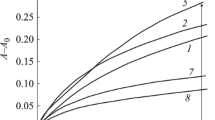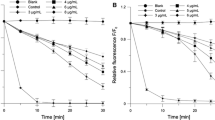Abstract
Much attention is given to research and development of efficient systems for the delivery of essential omega-3-polyunsaturated fatty acids and other nutraceuticals to the human body with food. Nanocomplexes, which are based on soybean phosphatidylcholine liposomes with nutraceuticals included, are among the efficient delivery systems. The prolonged use of these nanocomplexes may affect the antioxidant status in various organs and tissues. In this work, thermo-initiated chemiluminescence was used to study changes in the antioxidant activity of the blood plasma, liver, and brain lipids in mice divided into six groups depending on the composition of liposomal nanocomplexes introduced into drinks substituted for water in a long-term (3 month) diet. The components of six types of liposomal nanocomplexes, except for phosphatidylcholine, in different combinations were clove essential oil, fish oil, and sodium caseinate. The results of the study showed that nanocomplexes containing liposomes made of phosphatidylcholine with the addition of fish oil and clove essential oil and encapsulated in milk protein (sodium caseinate) proved to be the most effective in increasing the antioxidant activity of the blood plasma and brain lipids in mice compared to the control.




Similar content being viewed by others
REFERENCES
E. B. Burlakova, A. V. Alesenko, E. M. Molochkina, et al., Bioantioxidants in Radiation Damage and Malignant Growth (Nauka, Moscow, 1975).
E. B. Burlakova and N. P. Palmina, Vopr. Onkol. 36 (10), 1155 (1990).
E. B. Burlakova, Usp. Khim. 44 (10), 1871 (1975).
E. B. Burlakova, G. F. Ivanenko, and L. N. Shishkina, Izv. Akad. Nauk SSSR, Ser. Biol., No. 4, 588 (1985).
I. Popov, G. Lewin, G. Matthes, et al., Zh. Klin. Med. 43, 1663 (1988).
I. Popov, M. Popov, and G. Lewin, in Free Radicals and Oxidative Stress: Chemistry, Biochemistry and Pathophysiological Implications, Ed. by D. Galaris (Medimond, Ioannina, 2003), pp. 219–223.
I. N. Popov and G. Lewin, Biophysics (Moscow) 58 (5), 669 (2013).
E. B. Burlakova and N. G. Khrapova, Usp. Khim. 54 (9), 907 (1985).
E. B. Burlakova, S. A. Krashakov, and N. G. Khrapova, Biol. Membrany 15 (2), 161 (1998).
S. Dhavamani, Y. P. C. Rao, and B. R. Lokesh, Food Chem. 164, 551 (2014).
R. K. Saini and Y.-S. Keum, Life Sci. 203, 255 (2018).
N. R. Fuentesa, E. Kima, Y.-Y. Fana, and R. S. Chapkina, Mol. Aspects Med. 64, 79 (2018).
R. J. T. Mocking, J. Assies, H. G. Ruhe, and A. H. Schene, J. Inherited Metab. Dis. 41, 597 (2018).
M. Simonetto, M. Infante, R. L. Sacco, et al., Nutrients 11, 2279 (2019).
G. C. Candela, L. L. M. Bermejo, and K. V. Loria, Nutric. Hospital 26 (2), 323 (2011).
M. G. Semenova, A. S. Antipova, N. P. Palmina, et al., Khim. Fiz. 38 (12), 38 (2019)
M. G. Semenova, A. S. Antipova, D. V. Zelikina, et al., Food Res. Int. 88, 70 (2016).
R. S. Jope, D. J. Jenden, C. S. Subramanian, et al., Biochem. Pharmocol. 33 (5), 793 (1984).
T. A. Misharina, L. D. Fatkullina, E. S. Alinkina, et al., Appl. Biochem. Microbiol. 50 (1), 88 (2014).
K. J. Valentini, C. A. Pickens, J. A. Wiesinger, and J. I. Fenton, Int. J. Food Sci. Nutr. 69 (6), 705 (2018).
A. Balcerezyk, A. Gajewska, E. Macierzynska-Piotrowska, et al., Molecules 19, 14794 (2014).
S. S. Teh, S. H. Mah, S. W. Gouk, et al., J. Food Nutr. Res. 6 (1), 39 (2018).
T. G. Blaigh and W. J. Dyer, Can. J. Biochem. Physiol. 37, 911 (1959).
M. Kates, Techniques of Lipidology: Isolation, Analysis, and Identification of Lipids (North Holland, 1971; Mir, Moscow, 1975).
http://www.minilum.de.
I. Popov and G. Lewin, LABO 11, 8 (1997).
I. Popov and G. Lewin, Luminescence 20, 321 (2005).
I. Popov and G. Lewin, in Handbook of Chemiluminescent Methods in Oxidative Stress Assessment, Ed. by I. Popov and G. Lewin (Transworld Research Network, Kerala, 2008), pp. 361–391.
N. N. Sazhina, I. N. Popov, and V. N. Titov, Klin. Lab. Diagn. 63 (1), 16 (2018).
M. M. Sozarukova, A. M. Polimova, E. V. Proskurnina, and Yu. A. Vladimirov, Biophysics (Moscow) 61 (2), 284 (2016).
Yu. O. Teselkin, I. V. Babenkova, and A. N. Osipov, Biophysics (Moscow) 64 (5), 708 (2019).
M. L. Sagrista, A. E. Garcia, M. A. De Madariaga, and M. Mora, Free Radic. Res. 36 (3), 329 (2002).
E. A. Mengele, D. A. Krugovov, and O. T. Kasaikina, Izv. Akad. Nauk, Ser. Khim. 4 (1), 1 (2015).
Yu. A. Vladimirov and E. V. Proskurnina, Usp. Biol. Khim. 49, 341 (2009).
Yu. A. Vladimirov, Soros. Obraz. Zh. 7 (1), 16 (2001).
R. B. Hebbel and J. Lab. Clin. Med. 107, 401 (1986).
G. Lewin and I. Popov, Med. Hypoth. 42, 269 (1994).
E. B. Burlakova, E. M. Molochkina, N. P. Palmina, and L. V. Slepukhina, Vopr. Med. Khim. 22 (4), 541 (1976).
N. P. Palmina, L. K. Obukhova, and T. V. Bunto, Izv. Akad. Nauk SSSR, Ser. Biol. 2, 290 (1979).
E. B. Burlakova, N. M. Dzyuba, and N. P. Palmina, Biofizika 1 (5), 766 (1965).
T. Atsumi, S. Fujisawa, and K. Tonosaki, Toxicol. In Vitro 19,1025 (2005).
D. P. Bezerra, G. C. G. Militao, M. Castro de Morais and D. Pergentino de Sousa, Nutrients 9, 1367 (2017).
N. N. Sazhina, A. S. Antipova, M. G. Semenova, and N. P. Palmina, Russ. J. Bioorg. Chem. 45 (1), 34 (2019).
R. Rodrigo, J. C. Prieto, and R. Castillo, Clin. Sci. 124, 1 (2013).
ACKNOWLEDGMENTS
The authors thank Dr. I.N. Popov (Research Institute for Antioxidant Therapy, Berlin, Germany) for the scientific and technical support of this work, carried out within the framework of the cooperation agreement between the IBP RAS and the Research Institute of AT, and for critical reading of the manuscript. We also thank Oxidaq UG Ltd. (Berlin, Germany) for providing us with the Minilum® device and the required reagents.
Funding
This study was not sponsored.
Author information
Authors and Affiliations
Corresponding author
Ethics declarations
CONFLICT OF INTERESTS
The authors declare no conflicts of interest.
COMPLIANCE WITH ETHICAL STANDARDS
This work was performed in accordance with all applicable international, national, and institutional principles for the care and use of animals.
Additional information
Translated by I. Shipounova
Abbreviations: АОА, antioxidant activity; PUFAs, polyunsaturated fatty acids; PC, phosphatidylcholine; CEO, clove essential oil; Cas-Na, sodium caseinate; FO, fish oil; ACW, total antioxidant capacity of water-soluble plasma compounds; ACL, antioxidant capacity of lipid-soluble compounds in lipids; CL, chemiluminescence.
Rights and permissions
About this article
Cite this article
Sazhina, N.N., Semenova, M.G., Antipova, A.S. et al. The Effect of the Composition of a Liposomal Nanocomplex on the Antioxidant Activity of Murine Blood Plasma and Lipids of the Liver and Brain. BIOPHYSICS 65, 649–655 (2020). https://doi.org/10.1134/S0006350920040193
Received:
Revised:
Accepted:
Published:
Issue Date:
DOI: https://doi.org/10.1134/S0006350920040193




